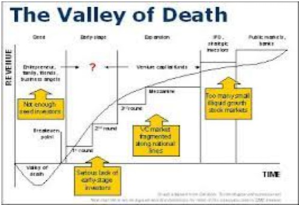
BY ROBIN GHOSH
( FORMER CHIEF ECONOMIST, BENGAL CHAMBER OF COMMERCE AND INDUSTRY)
KOLKATA, 6 OCTOBER 2023:
If you are planning to start a business, you better be aware of what is called as Death Valley Curve.
Death Valley Curve is a phase in business.
It is an initial phase while starting a new venture.
What happens in this phase is: the entrepreneur has already undertaken quite a bit of work. And spent quite a bit of money – but – not much revenue has been generated. During this period companies deplete their initial capital in their journey towards setting up the business.
It is interesting to explore how and by taking what steps — intelligent entrepreneurs navigate this “tricky” period ?
To meet this challenge, what entrepreneurs do is to analyse the strategic situation in which they are placed.
Generally speaking, companies navigating this Death Valley Curve face four phases.
It is like a matrix .You fall into one among four slots.
This matrix gets curated on the basis of two key challenges. And they are:
1. Does the new venture have the right business model?
2. Does the new venture have growth ambitions?

Testing the right Business Model
Now, how do we test that we have the right business model?
The entrepreneurs have to conduct two tests:
1. Narrative Test.
2. Number Test.
Any business enterprise gets through a narrative test when the story of the business model makes sense.
In other words it has logic and right alignment.
The number test is a numerical test. It is essentially a financial performing test of the business model.
Critical questions that arise are :
Is the business model producing profit? Does the turnover exceed costs? If yes, you have passed the numerical test.
Four Phases:
Every new enterprise passes through four phases. If you plot the business model in the form of a matrix, what comes up is four phases of a new enterprise. Each throwing up distinct challenges.
The four phases comprise of:
1.Shape-ups
2. Stand- ups
3. Start-ups
4. Scale – ups.
Let us start with the phrase Start- ups.
Important challenge for the start- ups is to find the right business model. Critical ingredients in this phase are:
1. Search for a competent business model
2. Constant Experimentation – trial and error methods.
3. Shift focus from one customer segment to another.
4. Develop new products and services.
5. Change payment option from fixed to subscription to on demand and back again.
6. Adopting differential sales and marketing means for capturing customers.
7. The credo is — you have to be flexible, nothing is fixed.
8. Strategy wise, you have to apply basic start up principles like failfast, trial, and error, co- creation
and crowd- funding alternatives.
9. Essentially, you have to define the right business model.
Shape – ups
1. Well you have reached your business objectives but you are still dithering to maintain a sustainable business volume.
2. You are unable to do so because your existing business logic is not working any more.
3. Why is it not working any more?
The answer is the market has changed or technology has changed ( personal digital assistants replaced by smartphones), value propositions challenged by competitors ( Uber challenging taxi business), changes in customer demands (trend towards non- smoking, preference towards vegetarian food, trend towards online coaching).
Here, competition is not the issue, in fact, customers have disappeared from the existing market.
What has happened is : the existing business model has become outdated and irrelevant – – even though you have achieved significant growth. Your business is on a declining slope.
Now, you have to shape up to survive and grow.
How do we do that?
1. Reinvent the Business model .
2. Change your entrepreneurial mindset.
How you reinvent the business model? Many alternatives are available :
1. Innovation
2. Business Development.
3. Strategic re- positioning
4. Disinvestment
How do you change your Entrepreneurial mindset?
1.Taking advise from professional Business Mentors
2. Attending professional management training in new business planning and development.
Stand- ups
The core challenge in this phase is to protect the business model both for today and tomorrow.
How?
1. Focus on customer centricity
2. Strategy to outperform and throw competitors out of the market.
3. Bias for action – no complacency.
4. Optimising processes and earnings.
5. Generating a new look business model.
Scale -ups
Once, the sustainable business model is erected, the next two issues are:
1. Scale – up by capturing an increasing number of customers as quickly as possible. (Digital- platform based business models)
2. Scale – up by replication of original business models (franchise based business).
While you scale up your business volume — you have to be equally ready to scale up your resources and capabilities.
Fund acquisition and human resources have to be in sync with customer growth.
We have identified four phases in which companies have to travel to build up business enterprises.
But not necessarily every entrepreneur has to face all the phases.
For example, Amazon lifted itself from start- up to scale up while Facebook was a start- up that had to find a business model.
To summarise, what are the learning lessons?
They are:
1. Diagnose which phase you are in
2. Focus on the important issues relevant to the phase you are in. And take required decisions.
3. Create an alignment between all the shareholders, between founders and investors.
The road out of the Valley of Death is riddled with a series of situational scenarios – each requiring crafting of corresponding strategy. And a cool tenor and intelligent design thinking.

Advertisement:
































Add Comment